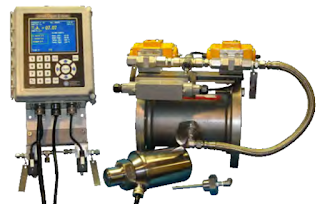If you’ve ever cracked open a crisp, cold beer on a Sunday, sampled a great wine, or asked yourself, “why does this soda taste so good?” you’ve had experience with what the process control industry calls “industrial refractometry.” Pink Floyd’s album cover for Dark Side of the Moon, where a beam of light hits a prism at a certain angle and then exits the other side in multiple colors, illustrates a core component of refractometry. Refractometry measures the speed at which light passes through an object.
Here’s how evaluating a substance with a refractometer works: a substance is placed on top of a prism. Then, a beam of light shines through the prism and reflects through the substance. The refractometer compares how much slower (or faster) light travels through the object compared to the speed of light through air. The comparison allows the evaluator to determine qualitative aspects of the substance, such as the density or concentration. For standardization purposes, the speed at which light passes through air has a refractive index (RI) value of 1. If a substance has an RI value of 1.16, light travels 16% quicker through air compared to the substance on the prism. Depending on the color and temperature of the reflected light, even more qualitative characteristics of the substance can be determined.
 |
| Electron Machine Inline Industrial Refractometer |
While the process won’t always help determine what exactly a substance is (different substances can have the same RI values), refractometry is essential in determining how something is. If a corporation knows the RI value of a liquid product, they can ensure each iteration of said product is precisely made, quantitatively and qualitatively. When two substances are being combined to create one resulting substance, refractometry can show exactly how close the combined substance is to being an accurate fusion.
Overall, refractometry is used by industrial companies as a control method. Industry professionals use refractometers to perform evaluations; these refractometers range from small, hand-held devices to full-powered, computer-controlled precision machines which measure the quality of every product coming out of on an assembly line. Refractometry is an objective way to prove standards are being met while achieving production excellence, making refractometry an extremely valuable tool for industrially geared businesses of almost every size.
So, the next time you want to combine coffee and creamer, if you know the refractive value of the best cup of coffee, you could use your own refractometer to measure how close you are to the perfect morning blend!
